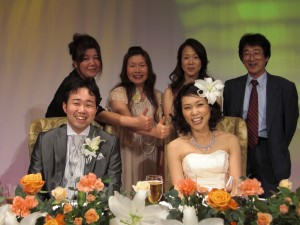2012年9月
9月16日の三佐子さん。京都グランビアホテル
2012/09/20
アメリカの甲状腺癌患者からの手紙
2012/09/18
医学研究に携わって多くの論文を書いてきましたが、研究内容が地味(?)なため、また基礎研究で重箱の隅をつつく内容(?)であるため、今まであまり注目を集めることはありませんでした。また治療に直接関与していないため、患者さんから感謝の言葉をいただいたこともありませんでした。しかし、先週初めて以下のようなmailを、面識のない患者(病院名、患者名は個人情報のため伏せさせていただきます)からいただき、インターネット情報はすごい、研究論文を書くことで患者に情報を発信し、時に役に立っているのだと実感することができ喜んでいます。どのような内容の論文であるか興味のある方はhttp://onlinelibrary.wiley.com/doi/10.1111/j.1440-1827.2011.02773.x/full をご参照ください。
Dear Dr. Kakudo,
I wanted to write and thank you for publishing your comprehensive review of the literature on encapsulated thyroid tumors, and your related papers. I am referring to Classification of thyroid follicular cell tumors: with special reference to borderline lesions (2011), and Encapsulated papillary thyroid carcinoma, follicular variant: a misnomer, (2012), which make many salient points and provide an excellent review of the literature for both professionals and interested patients.
I am a patient who was diagnosed with an encapsulated, mutation-negative, non-invasive thyroid cancer in 2011 in the United States. The pathology report read that it was an encapsulated classic PTC. I did wonder a bit at the time whether there could be some kind of question or error about the diagnosis because the tumor did not appear to have been behaving in a way that
could be construed as aggressive. There was no spread to the nodes or outside the thyroid, molecular tests revealed no known genetic mutations and I was also tg undetectable, both basal and stimulated. I was puzzled, and I did see while looking online that there was some kind of controversy about encapsulated FVPTC, but I was told that I didn’t have FVPTC and also that there are many cases of mutation negative thyroid cancer. I was also told that I was “low risk” but on the advice of my endocrinologist I submitted to a treatment of radioiodine (50 mCi). Like many or even most patients, when I was diagnosed I really had very little idea of the definition of thyroid cancer according to tumor classification and how that plays into the reasoning of a given pathologist. I had no way of contextualizing “thyroid cancer” in a more meaningful way. It seems that the hospital that I used treats classic encapsulated PTC the same as garden variety non-encapsulated PTC. I had no idea that encapsulated PTC could be
regarded as being under the same umbrella as encapsulated FVPTC until I did a Google search about it and saw your papers, which elucidate very effectively the problems of inter-observer variation among pathologists and also the questionable ascendency of PTC-N as a major diagnostic criterion. I would even go beyond that and say that any patient with this type of thyroid tumor who has been diagnosed with cancer and who can read and understand your reports will probably come away feeling rather
disturbed, or at the very least disconcerted by the implications. A cancer diagnosis entails a considerable psychological burden even when the prognosis is good.
It really surprised me to learn of the observer-dependent nature of the line between benign and malignant in certain situations. But I guess what unnerved me the most is the realization that pathologists and other clinicians at times actually do not know with certainty the true nature of some lesions due to the limitations of current knowledge. Yet these cases will nevertheless often be translated to the patient as definitively being cancer. How is a patient to react when confronted with this actuality, other than by experiencing a lessening of confidence in the way in which thyroid pathology is being conducted in many hospitals and also with nagging uncertainty about whether their case has been over-treated? I feel that I was not empowered as a patient and that more transparency is needed in medical practices as to the gaps in understanding in the current classification system, and the resultant gray zones in diagnosis which directly impact the lives of patients like me.
It seems to be the case that there is a certain segment of patients who are the unwitting “poster children” of this gray zone in thyroid pathology. My case proceeded on the basis of PTC-N (FNA and pathology) alone because the molecular results were negative. These uncertainties which have been unmasked by your reports suggest to me that a borderline category based upon degree of invasiveness is a very sensible solution until more hard data becomes available. At least I can attest to what a difference it would have made to me personally. Had I known of your research before I had my surgery and treatment, I may have
insisted on a lobectomy and almost certainly would not have agreed to receive RAI ablation. Since I saw your papers I conferred with a second pathologist from New England about them, and he confirmed that the diagnosis of these “very low grade lesions” is
subjective and sometimes even amounts to a “suggestion” from the pathologist. I only wish that my original pathologist could have somehow conveyed this information to me. Maybe many pathologists and clinicians in the USA and elsewhere feel that their
hands are tied due to legal concerns, but I think that for patients a borderline category makes very good sense and most likely will prevent overtreatment and psychological trauma. It would have made such a difference for me in that it would have allowed for a lesser degree of treatment while preserving appropriate follow-up.
Thank you again, Dr. Kakudo.








